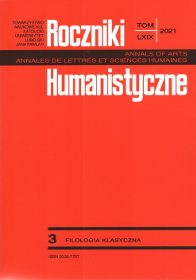„...dum Capitolium scandet cum tacita virgine pontifex”. Funkcja figury pochodu w pieśni III, 30 Exegi monumentum Horacego
“...dum Capitolium scandet cum tacita virgine pontifex”: The Function of the Figure of “Procession” in the Ode III, 30 Exegi monumentum of Horace
Author(s): Wojciech KopekSubject(s): Language and Literature Studies, Philology
Published by: Towarzystwo Naukowe KUL & Katolicki Uniwersytet Lubelski Jana Pawła II
Keywords: Horace; metapoetry; semiotics; rite of passage; dancing procession; komos; chorus
Summary/Abstract: This article contains a semiotic analysis of the “dancing procession” motif in Carm. III 30 Exegi monumentum (vv. 7–14) in the perspective of the topos of a meeting with a deity in the Horacian lyric, that was defined as a form of a rite of passage. The author also sought to answer the question of the function of the said motif in the composition of the text and in shaping the figure of the author’s subject, shown as a “poet” (vates). The posed research problem required the use of a semiotic definition of the text and forced an approach to the topos of a meeting with a deity as a cultural text. Which, in turn, bear in on reference to anthropology (the concept of ritual) and cultural studies (κῶμος, χορός), as well as linguistics in terms of semantics and the aspect of a verb. After the analysis the author concluded that the “dancing procession” motif in the ode Exegi monumentum is shown in two phases as a cyclical, ritual χορός, which became a sign of the one-time κῶμος. In this sense, the motif was shown as a figure of memory, referring to the fact that Horace combined Aeolian meters with Roman literature. In reply to the question regarding the figure of the subject, the author indicated that on the basis of the above figure of memory the vates was deified and as such he took the place of the deity in the literary transformation of the topos of the meeting with a deity, aspiring to a role analogous to the figure of “Anacreont” in Anacreontic poetry.
Journal: Roczniki Humanistyczne
- Issue Year: 69/2021
- Issue No: 3
- Page Range: 63-93
- Page Count: 31
- Language: Polish

